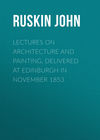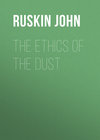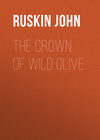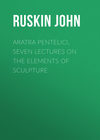Kitabı oku: «Lectures on Architecture and Painting, Delivered at Edinburgh in November 1853», sayfa 8
LECTURE IV.
PRE-RAPHAELITISM
Delivered November 18, 1853
107. The subject on which I would desire to engage your attention this evening, is the nature and probable result of a certain schism which took place a few years ago among our British artists.
This schism, or rather the heresy which led to it, as you are probably aware, was introduced by a small number of very young men; and consists mainly in the assertion that the principles on which art has been taught for these three hundred years back are essentially wrong, and that the principles which ought to guide us are those which prevailed before the time of Raphael; in adopting which, therefore, as their guides, these young men, as a sort of bond of unity among themselves, took the unfortunate and somewhat ludicrous name of "Pre-Raphaelite Brethren."
108. You must also be aware that this heresy has been opposed with all the influence and all the bitterness of art and criticism; but that in spite of these the heresy has gained ground, and the pictures painted on these new principles have obtained a most extensive popularity. These circumstances are sufficiently singular, but their importance is greater even than their singularity; and your time will certainly not be wasted in devoting an hour to an inquiry into the true nature of this movement.
I shall first, therefore, endeavor to state to you what the real difference is between the principles of art before and after Raphael's time, and then to ascertain, with you, how far these young men truly have understood the difference, and what may be hoped or feared from the effort they are making.
109. First, then, What is the real difference between the principles on which art has been pursued before and since Raphael? You must be aware, that the principal ground on which the Pre-Raphaelites have been attacked, is the charge that they wish to bring us back to a time of darkness and ignorance, when the principles of drawing, and of art in general, were comparatively unknown; and this attack, therefore, is entirely founded on the assumption that, although for some unaccountable reason we cannot at present produce artists altogether equal to Raphael, yet that we are on the whole in a state of greater illumination than, at all events, any artists who preceded Raphael; so that we consider ourselves entitled to look down upon them, and to say that, all things considered, they did some wonderful things for their time; but that, as for comparing the art of Giotto to that of Wilkie or Edwin Landseer, it would be perfectly ridiculous,—the one being a mere infant in his profession, and the others accomplished workmen.
Now, that this progress has in some things taken place is perfectly true; but it is true also that this progress is by no means the main thing to be noticed respecting ancient and modern art; that there are other circumstances, connected with the change from one to the other, immeasurably more important, and which, until very lately, have been altogether lost sight of.
110. The fact is, that modern art is not so much distinguished from old art by greater skill, as by a radical change in temper. The art of this day is not merely a more knowing art than that of the thirteenth century,—it is altogether another art. Between the two there is a great gulf, a distinction forever ineffaceable. The change from one to the other was not that of the child into the man, as we usually consider it; it was that of the chrysalis into the butterfly. There was an entire change in the habits, food, method of existence, and heart of the whole creature. That we know more than thirteenth century people is perfectly true; but that is not the essential difference between us and them. We are different kind of creatures from them,—as different as moths are different from caterpillars; and different in a certain broad and vast sense, which I shall try this evening to explain and prove to you;—different not merely in this or that result of minor circumstances,—not as you are different from people who never saw a locomotive engine, or a Highlander of this century from a Highlander of 1745;—different in a far broader and mightier sense than that; in a sense so great and clear, that we are enabled to separate all the Christian nations and tongues of the early time from those of the latter time, and speak of them in one group as the kingdoms of the Middle Ages. There is an infinite significance in that term, which I want you to dwell upon and work out; it is a term which we use in a dim consciousness of the truth, but without fully penetrating into that of which we are conscious. I want to deepen and make clear to you this consciousness that the world has had essentially a Trinity of ages—the Classical Age, the Middle Age, the Modern Age; each of these embracing races and individuals of apparently enormous separation in kind, but united in the spirit of their age,—the Classical Age having its Egyptians and Ninevites, Greeks and Romans,—the Middle Age having its Goths and Franks, Lombards and Italians,—the Modern Age having its French and English, Spaniards and Germans; but all these distinctions being in each case subordinate to the mightier and broader distinction, between Classicalism, Mediævalism, and Modernism.
111. Now our object to-night is indeed only to inquire into a matter of art; but we cannot do so properly until we consider this art in its relation to the inner spirit of the age in which it exists; and by doing so we shall not only arrive at the most just conclusions respecting our present subject, but we shall obtain the means of arriving at just conclusions respecting many other things.
Now the division of time which the Pre-Raphaelites have adopted, in choosing Raphael as the man whose works mark the separation between Mediævalism and Modernism, is perfectly accurate. It has been accepted as such by all their opponents.
You have, then, the three periods: Classicalism, extending to the fall of the Roman empire; Mediævalism, extending from that fall to the close of the fifteenth century; and Modernism thenceforward to our days.
112. And in examining into the spirit of these three epochs, observe, I don't mean to compare their bad men,—I don't mean to take Tiberius as a type of Classicalism, nor Ezzelin as a type of Mediævalism, nor Robespierre as a type of Modernism. Bad men are like each other in all epochs; and in the Roman, the Paduan, or the Parisian, sensuality and cruelty admit of little distinction in the manners of their manifestation. But among men comparatively virtuous, it is important to study the phases of character; and it is into these only that it is necessary for us to inquire. Consider therefore, first, the essential difference in character between three of the most devoted military heroes whom the three great epochs of the world have produced,—all three devoted to the service of their country,—all of them dying therein. I mean, Leonidas in the Classical period, St. Louis in the Mediæval period, and Lord Nelson in the Modern period.
Leonidas had the most rigid sense of duty, and died with the most perfect faith in the gods of his country, fulfilling the accepted prophecy of his death. St. Louis had the most rigid sense of duty, and the most perfect faith in Christ. Nelson had the most rigid sense of duty, and–
You must supply my pause with your charity.
Now you do not suppose that the main difference between Leonidas and Nelson lay in the modern inventions at the command of the one, as compared with the imperfect military instruments possessed by the other. They were not essentially different, in that the one fought with lances and the other with guns. But they were essentially different in the whole tone of their religious belief.
113. By this instance you may be partially prepared for the bold statement I am going to make to you, as to the change which constitutes Modernism. I said just now that it was like that of the worm to the butterfly. But the changes which God causes in His lower creatures are almost always from worse to better, while the changes which God allows man to make in himself are very often quite the other way; like Adam's new arrangement of his nature. And in saying that this last change was like that of a chrysalis, I meant only in the completeness of it, not in the tendency of it. Instead of from the worm to the butterfly, it is very possible it may have been from the butterfly to the worm.
Have patience with me for a moment after I tell you what I believe it to have been, and give me a little time to justify my words.
114. I say that Classicalism began, wherever civilization began, with Pagan Faith. Mediævalism began, and continued, wherever civilization began and continued to confess Christ. And, lastly, Modernism began and continues, wherever civilization began and continues to deny Christ.
You are startled, but give me a moment to explain. What, you would say to me, do you mean to tell us that we deny Christ? we who are essentially modern in every one of our principles and feelings, and yet all of us professing believers in Christ, and we trust most of us true ones? I answer, So far as we are believers indeed, we are one with the faithful of all times,—one with the classical believer of Athens and Ephesus, and one with the mediæval believer of the banks of the Rhone and the valleys of the Monte Viso. But so far as, in various strange ways, some in great and some in small things, we deny this belief, in so far we are essentially infected with this spirit, which I call Modernism.
115. For observe, the change of which I speak has nothing whatever to do with the Reformation, or with any of its effects. It is a far broader thing than the Reformation. It is a change which has taken place, not only in reformed England, and reformed Scotland; but in unreformed France, in unreformed Italy, in unreformed Austria. I class honest Protestants and honest Roman Catholics for the present together, under the general term Christians: if you object to their being so classed together, I pray your pardon, but allow me to do so at present, for the sake of perspicuity, if for nothing else; and so classing them, I say that a change took place, about the time of Raphael, in the spirit of Roman Catholics and Protestants both; and that change consisted in the denial of their religious belief, at least in the external and trivial affairs of life, and often in far more serious things.
116. For instance, hear this direction to an upholsterer of the early thirteenth century. Under the commands of the Sheriff of Wiltshire, he is thus ordered to make some alterations in a room for Henry the Third. He is to "wainscot the King's lower chamber, and to paint that wainscot of a green color, and to put a border to it, and to cause the heads of kings and queens to be painted on the borders; and to paint on the walls of the King's upper chamber the story of St. Margaret, Virgin, and the four Evangelists, and to paint the wainscot of the same chamber of a green color, spotted with gold."34
Again, the Sheriff of Wiltshire is ordered to "put two small glass windows in the chamber of Edward the King's son; and put a glass window in the chamber of our Queen at Clarendon; and in the same window cause to be painted a Mary with her Child, and at the feet of the said Mary, a queen with clasped hands."
Again, the Sheriff of Southampton is ordered to "paint the tablet beside the King's bed, with the figures of the guards of the bed of Solomon, and to glaze with white glass the windows in the King's great Hall at Northampton, and cause the history of Lazarus and Dives to be painted in the same."
117. And so on; I need not multiply instances. You see that in all these cases, the furniture of the King's house is made to confess his Christianity. It may be imperfect and impure Christianity, but such as it might be, it was all that men had then to live and die by; and you see there was not a pane of glass in their windows, nor a pallet by their bedside that did not confess and proclaim it. Now, when you go home to your own rooms, supposing them to be richly decorated at all, examine what that decoration consists of. You will find Cupids, Graces, Floras, Dianas, Jupiters, Junos. But you will not find, except in the form of an engraving, bought principally for its artistic beauty, either Christ, or the Virgin, or Lazarus and Dives. And if a thousand years hence, any curious investigator were to dig up the ruins of Edinburgh, and not know your history, he would think you had all been born heathens. Now that, so far as it goes, is denying Christ; it is pure Modernism.
"No," you will answer me, "you misunderstand and calumniate us. We do not, indeed, choose to have Dives and Lazarus on our windows; but that is not because we are moderns, but because we are Protestants, and do not like religious imagery." Pardon me: that is not the reason. Go into any fashionable lady's boudoir in Paris, and see if you will find Dives and Lazarus there. You will find, indeed, either that she has her private chapel, or that she has a crucifix in her dressing-room; but for the general decoration of the house, it is all composed of Apollos and Muses, just as it is here.
118. Again. What do you suppose was the substance of good education, the education of a knight, in the Middle Ages? What was taught to a boy as soon as he was able to learn anything? First, to keep under his body, and bring it into subjection and perfect strength; then to take Christ for his captain, to live as always in His presence, and finally, to do his devoir—mark the word—to all men. Now consider, first, the difference in their influence over the armies of France, between the ancient word "devoir," and modern word "gloire." And, again, ask yourselves what you expect your own children to be taught at your great schools and universities. Is it Christian history, or the histories of Pan and Silenus? Your present education, to all intents and purposes, denies Christ, and that is intensely and peculiarly Modernism.
119. Or, again, what do you suppose was the proclaimed and understood principle of all Christian governments in the Middle Ages? I do not say it was a principle acted up to, or that the cunning and violence of wicked men had not too often their full sway then as now; but on what principles were that cunning and violence, so far as was possible, restrained? By the confessed fear of God, and confessed authority of His law. You will find that all treaties, laws, transactions whatsoever, in the Middle Ages, are based on a confession of Christianity as the leading rule of life; that a text of Scripture is held, in all public assemblies, strong enough to be set against an appearance of expediency; and although, in the end, the expediency might triumph, yet it was never without a distinct allowance of Christian principle, as an efficient element in the consultation. Whatever error might be committed, at least Christ was openly confessed. Now what is the custom of your British Parliament in these days? You know that nothing would excite greater manifestations of contempt and disgust than the slightest attempt to introduce the authority of Scripture in a political consultation. That is denying Christ. It is intensely and peculiarly Modernism.
120. It would be easy to go on showing you this same thing in many more instances; but my business to-night is to show you its full effect in one thing only, namely, in art, and I must come straightway to that, as I have little enough time. This, then, is the great and broad fact which distinguishes modern art from old art; that all ancient art was religious, and all modern art is profane. Once more, your patience for an instant. I say, all ancient art was religious; that is to say, religion was its first object; private luxury or pleasure its second. I say all modern art is profane; that is, private luxury or pleasure is its first object; religion its second. Now you all know, that anything which makes religion its second object, makes religion no object. God will put up with a great many things in the human heart, but there is one thing He will not put up with in it—a second place. He who offers God a second place, offers Him no place. And there is another mighty truth which you all know, that he who makes religion his first object, makes it his whole object; he has no other work in the world than God's work. Therefore I do not say that ancient art was more religious than modern art. There is no question of degree in this matter. Ancient art was religious art; modern art is profane art; and between the two the distinction is as firm as between light and darkness.
121. Now, do not let what I say be encumbered in your minds with the objection, that you think art ought not to be brought into the service of religion. That is not the question at present—do not agitate it. The simple fact is, that old art was brought into that service, and received therein a peculiar form; that modern art is not brought into that service, and has received in consequence another form; that this is the great distinction between mediæval and modern art; and from that are clearly deducible all other essential differences between them. That is the point I wish to show you, and of that there can be no dispute. Whether or not Christianity be the purer for lacking the service of art, is disputable—and I do not mean now to begin the dispute; but that art is the impurer for not being in the service of Christianity, is indisputable, and that is the main point I have now to do with.
122. Perhaps there are some of you here who would not allow that the religion of the thirteenth century was Christianity. Be it so; still is the statement true, which is all that is necessary for me now to prove, that art was great because it was devoted to such religion as then existed. Grant that Roman Catholicism was not Christianity—grant it, if you will, to be the same thing as old heathenism—and still I say to you, whatever it was, men lived and died by it, the ruling thought of all their thoughts; and just as classical art was greatest in building to its gods, so mediæval art was great in building to its gods, and modern art is not great, because it builds to no God. You have, for instance, in your Edinburgh Library, a Bible of the thirteenth century, the Latin Bible, commonly known as the Vulgate. It contains the Old and New Testaments, complete, besides the books of Maccabees, the Wisdom of Solomon, the books of Judith, Baruch, and Tobit. The whole is written in the most beautiful black-letter hand, and each book begins with an illuminated letter, containing three or four figures, illustrative of the book which it begins. Now, whether this were done in the service of true Christianity or not, the simple fact is, that here is a man's life-time taken up in writing and ornamenting a Bible, as the sole end of his art; and that doing this, either in a book or on a wall, was the common artist's life at the time; that the constant Bible reading and Bible thinking which this work involved, made a man serious and thoughtful, and a good workman, because he was always expressing those feelings which, whether right or wrong, were the groundwork of his whole being. Now, about the year 1500, this entire system was changed. Instead of the life of Christ, men had, for the most part, to paint the lives of Bacchus and Venus; and if you walk through any public gallery of pictures by the "great masters," as they are called, you will indeed find here and there what is called a Holy Family, painted for the sake of drawing pretty children, or a pretty woman; but for the most part you will find nothing but Floras, Pomonas, Satyrs, Graces, Bacchanals, and Banditti. Now, you will not declare—you cannot believe—that Angelico painting the life of Christ, Benozzo painting the life of Abraham, Ghirlandajo painting the life of the Virgin, Giotto painting the life of St. Francis, were worse employed, or likely to produce a less healthy art, than Titian painting the loves of Venus and Adonis, than Correggio painting the naked Antiope, than Salvator painting the slaughters of the thirty years' war? If you will not let me call the one kind of labor Christian, and the other unchristian, at least you will let me call the one moral, and the other immoral, and that is all I ask you to admit.
123. Now observe, hitherto I have been telling you what you may feel inclined to doubt or dispute; and I must leave you to consider the subject at your leisure. But henceforward I tell you plain facts, which admit neither of doubt nor dispute by any one who will take the pains to acquaint himself with their subject-matter.
When the entire purpose of art was moral teaching, it naturally took truth for its first object, and beauty, and the pleasure resulting from beauty, only for its second. But when it lost all purpose of moral teaching, it as naturally took beauty for its first object, and truth for its second.
That is to say, in all they did, the old artists endeavored, in one way or another, to express the real facts of the subject or event, this being their chief business: and the question they first asked themselves was always, how would this thing, or that, actually have occurred? what would this person, or that, have done under the circumstances? and then, having formed their conception, they work it out with only a secondary regard to grace or beauty, while a modern painter invariably thinks of the grace and beauty of his work first, and unites afterwards as much truth as he can with its conventional graces. I will give you a single strong instance to make my meaning plainer. In Orcagna's great fresco of the Triumph of Death, one of the incidents is that three kings,35 when out hunting, are met by a spirit, which, desiring them to follow it, leads them to a churchyard, and points out to them, in open coffins, three bodies of kings such as themselves, in the last stages of corruption. Now a modern artist, representing this, would have endeavored dimly and faintly to suggest the appearance of the dead bodies, and would have made, or attempted to make, the countenances of the three kings variously and solemnly expressive of thought. This would be in his, or our, view, a poetical and tasteful treatment of the subject. But Orcagna disdains both poetry and taste; he wants the facts only; he wishes to give the spectator the same lesson that the kings had; and therefore, instead of concealing the dead bodies, he paints them with the most fearful detail. And then, he does not consider what the three kings might most gracefully do. He considers only what they actually in all probability would have done. He makes them looking at the coffins with a startled stare, and one holding his nose. This is an extreme instance; but you are not to suppose it is because Orcagna had naturally a coarse or prosaic mind. Where he felt that thoughtfulness and beauty could properly be introduced, as in his circles of saints and prophets, no painter of the Middle Ages is so grand. I can give you no better proof of this, than the one fact that Michael Angelo borrowed from him openly—borrowed from him in the principal work which he ever executed, the Last Judgment, and borrowed from him the principal figure in that work. But it is just because Orcagna was so firmly and unscrupulously true, that he had the power of being so great when he chose. His arrow went straight to the mark. It was not that he did not love beauty, but he loved truth first.
124. So it was with all the men of that time. No painters ever had more power of conceiving graceful form, or more profound devotion to the beautiful; but all these gifts and affections are kept sternly subordinate to their moral purpose; and, so far as their powers and knowledge went, they either painted from nature things as they were, or from imagination things as they must have been.
I do not mean that they reached any imitative resemblance to nature. They had neither skill to do it, nor care to do it. Their art was conventional and imperfect, but they considered it only as a language wherein to convey the knowledge of certain facts; it was perfect enough for that; and though always reaching on to greater attainments, they never suffered their imperfections to disturb and check them in their immediate purposes. And this mode of treating all subjects was persisted in by the greatest men until the close of the fifteenth century.
125. Now so justly have the Pre-Raphaelites chosen their time and name, that the great change which clouds the career of mediæval art was affected, not only in Raphael's time, but by Raphael's own practice, and by his practice in the very center of his available life.
You remember, doubtless, what high ground we have for placing the beginning of human intellectual strength at about the age of twelve years.36 Assume, therefore, this period for the beginning of Raphael's strength. He died at thirty-seven. And in his twenty-fifth year, one half-year only past the precise center of his available life, he was sent for to Rome, to decorate the Vatican for Pope Julius II., and having until that time worked exclusively in the ancient and stern mediæval manner, he, in the first chamber which he decorated in that palace, wrote upon its walls the Mene, Tekel, Upharsin of the Arts of Christianity.
And he wrote it thus: On one wall of that chamber he placed a picture of the World or Kingdom of Theology, presided over by Christ. And on the side wall of that same chamber he placed the World or Kingdom of Poetry, presided over by Apollo. And from that spot, and from that hour, the intellect and the art of Italy date their degradation.
126. Observe, however, the significance of this fact is not in the mere use of the figure of the heathen god to indicate the domain of poetry. Such a symbolical use had been made of the figures of heathen deities in the best times of Christian art. But it is in the fact, that being called to Rome especially to adorn the palace of the so-called head of the Church, and called as the chief representative of the Christian artists of his time, Raphael had neither religion nor originality enough to trace the spirit of poetry and the spirit of philosophy to the inspiration of the true God, as well as that of theology; but that, on the contrary, he elevated the creations of fancy on the one wall, to the same rank as the objects of faith upon the other; that in deliberate, balanced opposition to the Rock of the Mount Zion, he reared the rock of Parnassus, and the rock of the Acropolis; that, among the masters of poetry we find him enthroning Petrarch and Pindar, but not Isaiah nor David, and for lords over the domain of philosophy we find the masters of the school of Athens, but neither of those greater masters by the last of whom that school was rebuked,—those who received their wisdom from heaven itself, in the vision of Gibeon,37 and the lightning of Damascus.
127. The doom of the arts of Europe went forth from that chamber, and it was brought about in great part by the very excellencies of the man who had thus marked the commencement of decline. The perfection of execution and the beauty of feature which were attained in his works, and in those of his great contemporaries, rendered finish of execution and beauty of form the chief objects of all artists; and thenceforward execution was looked for rather than thought, and beauty rather than veracity.
And as I told you, these are the two secondary causes of the decline of art; the first being the loss of moral purpose. Pray note them clearly. In mediæval art, thought is the first thing, execution the second; in modern art execution is the first thing, and thought the second. And again, in mediæval art, truth is first, beauty second; in modern art, beauty is first, truth second. The mediæval principles led up to Raphael, and the modern principles lead down from him.
128. Now, first, let me give you a familiar illustration of the difference with respect to execution. Suppose you have to teach two children drawing, one thoroughly clever and active-minded, the other dull and slow; and you put before them Jullien's chalk studies of heads—études à deux crayons—and desire them to be copied. The dull child will slowly do your bidding, blacken his paper and rub it white again, and patiently and painfully, in the course of three or four years, attain to the performance of a chalk head, not much worse than his original, but still of less value than the paper it is drawn upon. But the clever child will not, or will only by force, consent to this discipline. He finds other means of expressing himself with his pencil somehow or another; and presently you find his paper covered with sketches of his grandfather and grandmother, and uncles, and cousins—sketches of the room, and the house, and the cat, and the dog, and the country outside, and everything in the world he can set his eyes on; and he gets on, and even his child's work has a value in it—a truth which makes it worth keeping; no one knows how precious, perhaps, that portrait of his grandfather may be, if any one has but the sense to keep it till the time when the old man can be seen no more up the lawn, nor by the wood. That child is working in the Middle-Age spirit—the other in the modern spirit.
129. But there is something still more striking in the evils which have resulted from the modern regardlessness of truth. Consider, for instance, its effect on what is called historical painting. What do you at present mean by historical painting? Now-a-days it means the endeavoring, by the power of imagination, to portray some historical event of past days. But in the Middle Ages, it meant representing the acts of their own days; and that is the only historical painting worth a straw. Of all the wastes of time and sense which Modernism has invented—and they are many—none are so ridiculous as this endeavor to represent past history. What do you suppose our descendants will care for our imaginations of the events of former days? Suppose the Greeks, instead of representing their own warriors as they fought at Marathon, had left us nothing but their imaginations of Egyptian battles; and suppose the Italians, in like manner, instead of portraits of Can Grande and Dante, or of Leo the Tenth and Raphael, had left us nothing but imaginary portraits of Pericles and Miltiades? What fools we should have thought them! how bitterly we should have been provoked with their folly! And that is precisely what our descendants will feel towards us, so far as our grand historical and classical schools are concerned. What do we care, they will say, what those nineteenth century people fancied about Greek and Roman history! If they had left us a few plain and rational sculptures and pictures of their own battles, and their own men, in their every-day dress, we should have thanked them. "Well, but," you will say, "we have left them portraits of our great men, and paintings of our great battles." Yes, you have indeed, and that is the only historical painting that you either have, or can have; but you don't call that historical painting. You don't thank the men who do it; you look down upon them and dissuade them from it, and tell them they don't belong to the grand schools. And yet they are the only true historical painters, and the only men who will produce any effect on their own generation, or on any other. Wilkie was a historical painter, Chantrey a historical sculptor, because they painted, or carved, the veritable things and men they saw, not men and things as they believed they might have been, or should have been. But no one tells such men they are historical painters, and they are discontented with what they do; and poor Wilkie must needs travel to see the grand school, and imitate the grand school, and ruin himself. And you have had multitudes of other painters ruined, from the beginning, by that grand school. There was Etty, naturally as good a painter as ever lived, but no one told him what to paint, and he studied the antique, and the grand schools, and painted dances of nymphs in red and yellow shawls to the end of his days. Much good may they do you! He is gone to the grave, a lost mind. There was Flaxman, another naturally great man, with as true an eye for nature as Raphael,—he stumbles over the blocks of the antique statues—wanders in the dark valley of their ruins to the end of his days. He has left you a few outlines of muscular men straddling and frowning behind round shields. Much good may they do you! Another lost mind. And of those who are lost namelessly, who have not strength enough even to make themselves known, the poor pale students who lie buried forever in the abysses of the great schools, no account can be rendered; they are numberless.
"Ich am aferd.""Lo, whet ich se?""Me thinketh hit beth develes thre." To which the dead bodies answer—
"Ich wes wel fair.""Such scheltou be.""For Godes love, be wer by me." It is curious, that though the dresses of the living persons, and the "I was well fair" of the first dead speaker, seem to mark them distinctly to be women, some longer legends below are headed "primus rex mortuus," etc.









![Stones of Venice [introductions]](https://cdn.litres.ru/pub/c/cover_100/34843654.jpg)
